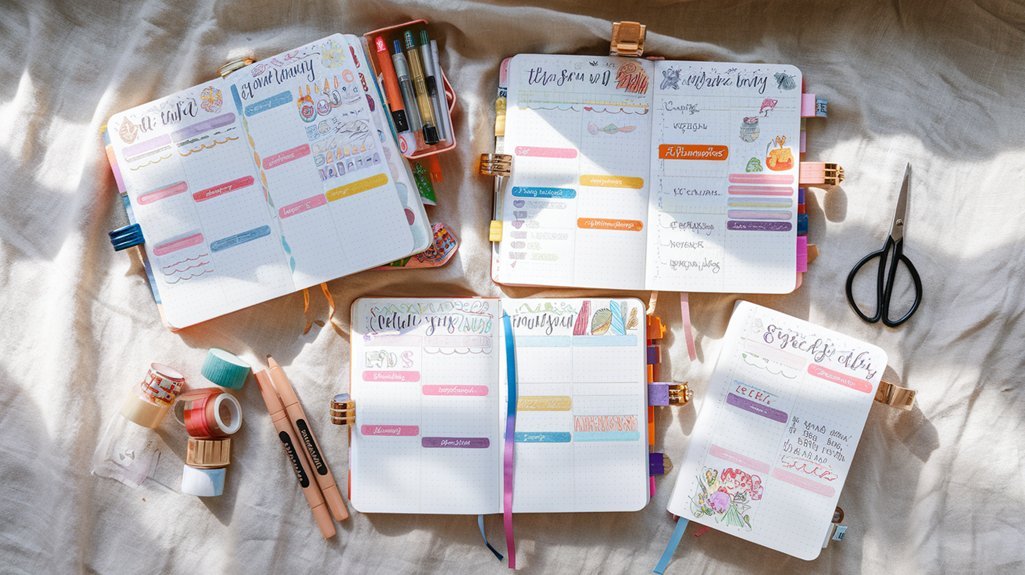Bullet journal habit trackers effectively convert abstract goals into measurable daily actions through systematic monitoring. The simple act of marking completed tasks triggers dopamine releases, reinforcing positive behaviors while visual progress indicators provide instant feedback. Monthly overviews reveal deeper behavior patterns through color coding and trend analysis. Clear layouts like minimalist grids and circular progress wheels maximize both functionality and aesthetic appeal. Discovering the right tracking system unveils sustainable personal transformation.
Why Habit Trackers Work: The Psychology Behind Success

The simple act of tracking habits triggers powerful psychological mechanisms that drive behavioral change. When individuals monitor their daily actions through habit trackers, they activate a self-awareness loop that strengthens their commitment to personal goals. This systematic observation creates a feedback system that naturally leads to behavior reinforcement.
Research shows that habit trackers work by capitalizing on the brain's reward pathways. Each time a person marks a completed task, they experience a small dopamine release, creating personalized incentives that motivate continued action. The visual representation of progress serves as a powerful reminder of both successes and areas needing improvement.
Additionally, habit trackers establish accountability through concrete data rather than relying on memory or perception. This objective record-keeping transforms vague intentions into measurable outcomes, making it easier to identify patterns, adjust strategies, and maintain long-term motivation. The process becomes self-reinforcing as users witness their own progress documented over time.
Essential Components of an Effective Habit Tracker
An effective habit tracker requires three core visual elements to maximize tracking success. Clear progress indicators allow users to instantly assess habit completion status, while simple daily checkboxes create an intuitive system for marking completed tasks. A monthly progress overview provides the bigger picture, enabling users to identify patterns and maintain long-term motivation through visible achievement records.
Clear Visual Progress Indicators
Clear visual progress indicators serve as the cornerstone of successful habit tracking, enabling users to instantly assess their consistency and achievement levels at a glance. These indicators utilize unobtrusive visual cues like color-coding, symbols, or simple checkmarks to represent completed actions and missed opportunities.
Effective trackers incorporate easily interpreted metrics through minimal designs that highlight patterns and trends. Common visual elements include progress bars, dot grids, or simple boxes that can be filled, crossed, or shaded. These clear markers eliminate confusion and maintain focus on the tracked behaviors rather than the tracking system itself.
The visual system should provide immediate feedback while remaining simple enough to maintain over time. When designed properly, these indicators create a powerful motivational tool by translating abstract goals into concrete, measurable progress that drives continued engagement and success.
Simple Daily Checkboxes
Simple daily checkboxes represent the foundational building block of effective habit tracking systems, offering users a straightforward method to record their daily progress. This structured format allows individuals to maintain consistency while working toward their personalized goals through a clear yes/no completion system.
The power of daily checkboxes lies in their simplicity and effectiveness:
- Users can quickly mark completed habits without spending excessive time on complicated tracking methods
- The binary nature of checkboxes eliminates ambiguity and promotes honest self-assessment
- The visual layout creates an immediate understanding of performance patterns and accountability
When implemented consistently, these minimal tracking elements transform abstract goals into measurable actions. The checkbox system's straightforward design helps maintain focus on habit formation rather than getting lost in complex tracking mechanisms.
Monthly Progress Overview
Building upon the daily checkbox system, monthly progress overviews provide users with an extensive visualization of their habit development across a broader timeframe. This detailed view enables seasonal goal reflection and facilitates quarterly milestone checkpoints.
| Progress Element | Purpose | Outcome |
|---|---|---|
| Color Coding | Visual Pattern Recognition | Quick Progress Assessment |
| Success Rates | Data-Driven Insights | Behavior Pattern Analysis |
| Trend Lines | Development Tracking | Strategic Adjustments |
Monthly overviews transform scattered daily data into actionable insights, revealing patterns that might otherwise remain hidden. Users can identify which habits gain momentum and which require additional attention. This bird's-eye perspective empowers journal keepers to make informed decisions about habit modification, goal adjustment, and resource allocation, ultimately leading to more effective personal development strategies.
Popular Habit Tracking Layouts and Designs
Bullet journal enthusiasts have developed several effective habit tracking layouts to monitor their daily routines and progress. Popular designs include minimalist monthly grid layouts for at-a-glance progress checks, circular progress wheels that provide visual satisfaction when completing segments, and color-coded habit charts that organize multiple habits by category or priority. These versatile tracking methods allow users to select formats that match their aesthetic preferences while maintaining practical functionality for consistent habit monitoring.
Minimalist Monthly Grid Layouts
Monthly grid layouts provide an efficient foundation for minimalist habit tracking, featuring clean lines and essential elements that maximize space while maintaining visual clarity. These customizable grid layouts allow users to monitor multiple habits simultaneously while adhering to minimalist design elements that reduce visual clutter.
Effective minimalist monthly grids incorporate three key components:
- Simple date-based rows and columns that create an easy-to-scan matrix
- Binary marking systems using dots, crosses, or single-color highlighting
- Streamlined habit labels that utilize abbreviated text or symbols
The straightforward nature of these layouts enables quick daily entries while providing clear progress visualization. Users can adapt the basic framework to accommodate varying numbers of habits while preserving the clean aesthetic that defines minimalist tracking. This approach proves particularly effective for maintaining long-term tracking consistency.
Circular Progress Wheels
Circular progress wheels represent one of the most visually dynamic approaches to habit tracking, combining artistic appeal with functional monitoring capabilities. These radial progress visualization tools enable users to track multiple habits simultaneously through concentric habit circles, with each ring dedicated to a specific behavior or goal.
The design consists of a central point with expanding circles divided into segments representing days or weeks. Users shade or color each segment upon habit completion, creating a growing pattern that instantly communicates progress. The outer rings can track daily habits while inner circles monitor weekly or monthly goals. This layout particularly excels at revealing patterns and correlations between different habits over time. For ideal effectiveness, practitioners typically limit tracking to 4-6 key habits per wheel, maintaining clarity and preventing visual overwhelm.
Color-Coded Habit Charts
While many bullet journaling methods exist, color-coded habit charts stand out as highly effective visual tools that combine organization with instant recognizability. These custom habit tracker designs utilize seasonal color palettes to categorize different types of behaviors and goals, making progress monitoring both intuitive and engaging.
Key benefits of color-coded habit tracking include:
- Rapid pattern recognition through distinct color associations for different habit categories
- Enhanced motivation from visually appealing layouts that encourage daily engagement
- Simplified data analysis through color-grouped behaviors that reveal success patterns
Color-coding systems can range from simple two-tone formats to elaborate rainbow schemes. Users often align their color selections with seasonal color palettes that reflect specific time periods or match their journal's overall aesthetic theme, creating cohesive and personalized tracking experiences.
Setting Up Your First Habit Tracker
Getting started with a habit tracker requires just a few basic supplies and clear objectives. A blank notebook, ruler, pen, and optional colored markers provide the foundation for effective routine planning. The initial setup should focus on selecting 3-5 key habits to monitor, preventing overwhelm and increasing success rates.
To create the tracker, draw a simple grid with dates along the top and habits listed vertically down the left side. Each intersection represents a daily checkpoint for habit completion. This straightforward layout supports habit building strategies through visual accountability and progress monitoring.
The next step involves establishing clear success criteria for each habit. Whether it's “drink 8 glasses of water” or “exercise for 30 minutes,” specific metrics enable accurate tracking. Users should mark completed habits daily, preferably at a consistent time. This systematic approach transforms vague intentions into measurable actions, creating a framework for sustainable behavior change.
Common Habits Worth Tracking for Personal Growth
With a clear tracking system in place, selecting impactful habits becomes the next focus for personal development. Creating meaningful habits requires identifying behaviors that contribute to holistic wellbeing across multiple life domains. The most effective habit trackers monitor activities that align with long-term goals while remaining manageable in daily practice.
Key habits that consistently drive personal growth include:
- Physical wellness activities: daily exercise, water intake, sleep duration, and nutritious meal preparation
- Mental development practices: reading time, learning new skills, meditation, and journaling
- Productivity behaviors: task completion, focused work sessions, email management, and meeting deadlines
Integrating holistic wellbeing into habit tracking guarantees balanced growth across health, career, and personal dimensions. Successful trackers start with 2-3 habits per category, gradually expanding as initial behaviors become automatic. This measured approach prevents overwhelm while establishing sustainable lifestyle changes that support continuous improvement.
Digital vs. Analog Tracking: Choosing Your Method
Modern habit trackers face a fundamental choice between digital apps and traditional paper-based systems, each offering distinct advantages for different user preferences and lifestyle needs. Analog vs. digital habit tracking presents contrasting benefits in accessibility, customization, and reliability.
Digital platforms excel with automated reminders, data analysis, and cloud-based synchronization across devices. These systems offer instant backup, sharing capabilities, and sophisticated tracking metrics. Cloud-based habit trackers particularly benefit users who frequently switch between devices or require detailed progress analytics.
Paper-based habit trackers provide tangible engagement, creative freedom, and independence from technology. The physical act of writing reinforces commitment and memory retention, while the absence of digital distractions maintains focus. Traditional bullet journals allow unlimited customization without software constraints or subscription fees.
The choice between analog and digital methods ultimately depends on personal workflow, technological comfort level, and specific tracking objectives. Many users successfully combine both approaches to maximize their habit-building effectiveness.
Strategies for Maintaining Long-Term Consistency

Successful habit trackers recognize that celebrating small daily achievements reinforces positive behavior patterns. By documenting each instance of progress, no matter how minor, users build momentum and maintain motivation for long-term goals. Linking complementary habits, such as meditation after morning coffee or reading before bedtime, creates natural behavior chains that increase the likelihood of consistent practice.
Track Small Wins Daily
Celebrating daily achievements, no matter how small, creates a powerful momentum for long-term habit formation. Daily habit reflection helps individuals recognize progress and maintain accountability, even when changes seem minimal. By documenting small wins, people stay motivated and build confidence in their ability to achieve larger goals.
To effectively track small wins in a bullet journal:
- Create a dedicated “Wins” section on each daily spread, listing 2-3 positive actions or milestones
- Use color-coding or symbols to categorize different types of achievements, making patterns more visible
- Review weekly totals of small wins to reinforce progress and identify areas needing attention
This systematic approach to small wins accountability transforms abstract goals into tangible results, making success measurable and sustainable. Regular tracking builds resilience and maintains focus on continuous improvement.
Link Habits Together
Connecting multiple habits through strategic linking creates a powerful chain reaction of behavioral change. By intentionally pairing complementary behaviors, individuals can leverage existing routines to establish new habits more effectively.
Linking complementary habits works by using an established behavior as a trigger for a new desired action. For example, connecting a morning meditation practice with an existing coffee routine creates a natural progression. This technique of combining habit accountability strengthens both behaviors while reducing the mental effort needed to maintain them.
Successful habit linking requires identifying logical connection points between desired behaviors. Morning routines can connect to exercise, which links to healthy eating, creating a cascade of positive choices. The key is selecting habits that naturally flow together and support broader lifestyle goals.
Overcoming Tracking Plateaus and Setbacks
Maintaining consistent progress with habit tracking can face unexpected obstacles and temporary declines in motivation. Overcoming barriers requires a strategic approach that acknowledges setbacks as natural parts of the journey while maintaining motivation through proven techniques.
Consistency in habit tracking isn't about perfection – it's about having a strategic mindset when obstacles arise and motivation dips.
When encountering tracking plateaus, successful bullet journal users implement these evidence-based strategies:
- Reset and evaluate tracking methods by analyzing which habits feel forced versus those that naturally align with daily routines
- Adjust goals to be more realistic and achievable, breaking larger habits into smaller micro-commitments that build momentum
- Implement a “bounce back” protocol that includes pre-planned steps for returning to tracking after missed days
Advanced Techniques for Multiple Habit Management

Once bullet journal users master basic tracking methods and overcome initial setbacks, they often seek to expand their tracking capabilities to monitor multiple habits simultaneously. Advanced practitioners employ sophisticated habit formation strategies, including color-coding systems, interconnected spreads, and priority matrices to manage complex behavioral changes.
Successful multiple habit management requires systematic organization and data-driven progress analysis. Users can implement tiered tracking systems, categorizing habits by frequency, difficulty, or life domain. This approach enables them to identify patterns, correlations, and potential conflicts between different habits. Weekly review sessions become essential for evaluating progress across all tracked behaviors.
Advanced trackers often incorporate milestone markers, progress indicators, and achievement metrics to maintain momentum across multiple goals. By utilizing specialized symbols, conditional formatting, and cross-referencing techniques, users can efficiently monitor numerous habits while preventing tracking fatigue and maintaining clear visual hierarchies in their journal layouts.
Using Data to Optimize Your Habit System
The systematic collection and analysis of habit tracking data enables bullet journal users to refine their systems for maximum effectiveness. By leveraging analytics and data visualization techniques, individuals can identify patterns, bottlenecks, and opportunities for optimization in their habit-building journey.
Key steps for data-driven habit optimization include:
- Recording daily metrics consistently, including completion rates, timing, and contextual factors that influence success or failure
- Conducting weekly and monthly reviews to analyze trends through simple charts, graphs, or color-coded systems
- Implementing targeted adjustments based on insights, such as modifying habit timing or breaking complex habits into smaller components
This analytical approach transforms raw tracking data into actionable intelligence. Users can pinpoint which habits yield the highest impact, which combinations work synergistically, and which environmental factors support or hinder progress. Regular system optimization based on personal data leads to higher success rates and more sustainable habit formation over time.
Conclusion
Bullet journal habit trackers transform scattered aspirations into tangible victories through methodical documentation and visual accountability. When life's diversions threaten to derail progress, these carefully crafted systems gently guide individuals back on course. By implementing strategic tracking methods, personalizing layouts, and analyzing patterns, anyone can elevate their daily routines into stepping stones toward meaningful achievement. The path to lasting change begins with a single mark on the tracker.








